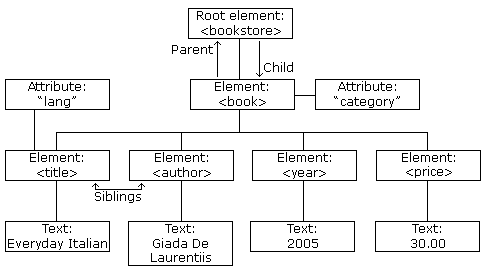用Python的minidom写XML
2017-11-22 15:29:30 +08 字数:1543 标签: Python读、或者说解析XML的需求很常见,而写、或者说生成XML的需求就比较少见。 并且在很多情况下,用字符串手写、拼接,也非常的方便快捷。 然而,总有一些时候,需要用结构化的方式,去写一些复杂的XML。
经过挑选,孤选择了Python的minidom。
XML简介 ¶
XML(eXtensible Markup Language,可扩展标记语言),是一种可用于任何类型的结构化数据的通用型语言。 它被设计来保存与传递数据,是一种W3C推荐的规范。 虽然形式与HTML类似,但XML没有任何预定义的Tag,具备很高的可扩展性。

上图与以下代码,都源于XML Tutorial。 这个例子清晰地展示了XML对数据结构的表达。
<?xml version="1.0" encoding="UTF-8"?>
<bookstore>
<book category="cooking">
<title lang="en">Everyday Italian</title>
<author>Giada De Laurentiis</author>
<year>2005</year>
<price>30.00</price>
</book>
<book category="children">
<title lang="en">Harry Potter</title>
<author>J K. Rowling</author>
<year>2005</year>
<price>29.99</price>
</book>
<book category="web">
<title lang="en">Learning XML</title>
<author>Erik T. Ray</author>
<year>2003</year>
<price>39.95</price>
</book>
</bookstore>
概念 ¶
要想写XML,需要先知道基本概念。 因为工具都是根据概念来设计的,知道概念就很容易明白有哪些接口、分别是什么功能。
XML的核心概念可以用以下代码片表示。
<?xml version="1.0" encoding="UTF-8"?>
<!-- comment -->
<root>
<element attribute="0">text</element>
<sibling attribute="1">text</sibling>
</root>
- XML是树状结构,基本单元是node。 element就是一个node。
- element之间可以有父子关系(parent-child)。 每个element最多只有一个parent,可以有多个child。
- 每一个XML都有且仅有一个特殊的element,是为root。 在父子关系上,它是所有element的祖先。
- element可以有兄弟关系(sibling),它们共享同一个parent。
- 每个element都可以有若干个attribute。
- 每个element都可以有一个text,它也是一个node。
由于是用工具写,而非手写,所以一些语法细节,可以不用关注。 详见XML Syntax。
使用minidom ¶
from xml.dom import minidom
写一个XML,大概过程是:
- 创建Document
- 创建element、定制attribute与text
- 输出Document
创建Document ¶
xml = minidom.Document()
一个Document,其实就是一个XML文件。
创建root ¶
root = xml.createElement('root')
xml.appendChild(root)
要注意两点:
- 需要使用
appendChild,element才真的出现在Document中。 - 一个Document只能有一个root,Document级别的
appendChild只能使用一次。
创建element ¶
child = xml.createElement('child')
root.appendChild(child)
和root相比,普通element都是以root或其它element来调用appendChild。
设置attribute ¶
child.setAttribute('attr', '0')
attribute的值,必须是字符串。
设置text ¶
node = xml.createTextNode('text')
child.appendChild(node)
text也是一个node,要像node一样去操作。
输出 ¶
minidom一共有两种输出方式,一是输出为字符串,二是输出到writer。 但归根结底,还是输出到writer。
def toxml(self, encoding = None):
return self.toprettyxml("", "", encoding)
def toprettyxml(self, indent="\t", newl="\n", encoding = None):
# indent = the indentation string to prepend, per level
# newl = the newline string to append
writer = _get_StringIO()
if encoding is not None:
import codecs
# Can't use codecs.getwriter to preserve 2.0 compatibility
writer = codecs.lookup(encoding)[3](writer)
if self.nodeType == Node.DOCUMENT_NODE:
# Can pass encoding only to document, to put it into XML header
self.writexml(writer, "", indent, newl, encoding)
else:
self.writexml(writer, "", indent, newl)
return writer.getvalue()
从以上源码中可以看出,其实toxml是用toprettyxml实现的,而toprettyxml则是用writexml来实现的。
输出时,可以指定XML的encoding,以及缩进、换行符。
>>> xml.toxml()
'<?xml version="1.0" ?><root><child attr="0">text</child></root>'
>>> print(xml.toprettyxml())
<?xml version="1.0" ?>
<root>
<child attr="0">text</child>
</root>
>>> import sys
>>> xml.writexml(sys.stdout, '', ' ' * 4, '\n', 'UTF-8')
<?xml version="1.0" encoding="UTF-8"?>
<root>
<child attr="0">text</child>
</root>
可以看到,之前写的root、child等内容,都在其中。
需要打印到文件时,把上面writexml中的sys.stdout换成文件对象即可。
手写混合 ¶
如果需要混合一些既有的XML片段,到生成到一半的Document中,这时可以使用minidom提供的解析功能。
>>> hello = minidom.parseString('<hello>world</hello>')
>>> root.appendChild(hello.firstChild)
>>> xml.writexml(sys.stdout, '', ' ' * 4, '\n', 'UTF-8')
<?xml version="1.0" encoding="UTF-8"?>
<root>
<child attr="0">text</child>
<hello>world</hello>
</root>
总结 ¶
本文只是简单介绍如何生成一个XML文件,相信以上内容就已经足够了。 通过minidom,也可以对既有的XML进行一些解析、查找、修改。